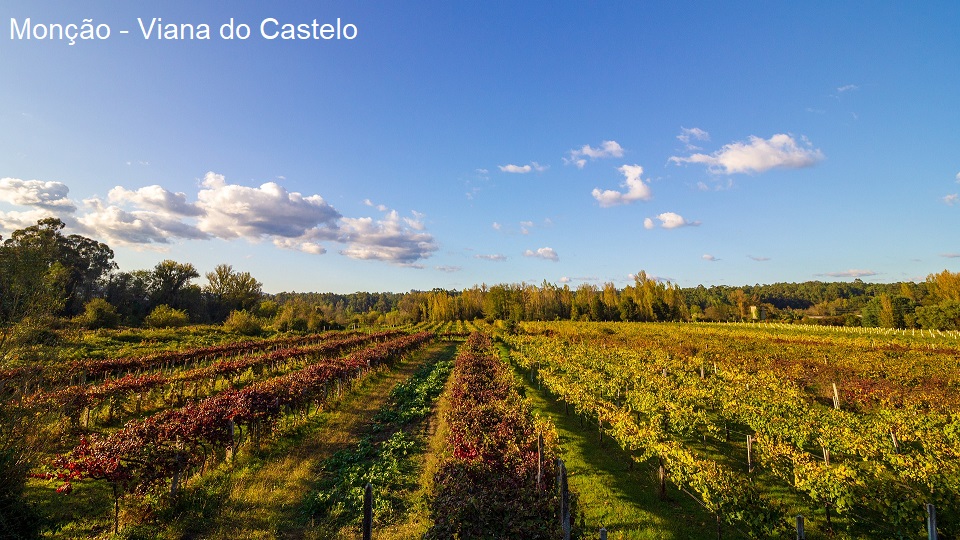Results
2,284 Results
Loading more Results ...
Loading more Results ...
Wine regions in Vinho Verde 4 growing regions
Description to Vinho Verde
The Portuguese DOC area for red and white wines was already defined by law in 1908. The huge area covers 60,000 hectares of vineyards in the districts of Braga, Porto and Viana do Castelo. It stretches 130 kilometres long and 70 kilometres wide in the northwest of Portugal between the Douro River and the Minho River, which forms the border with Spain. The entire area is also classified as an IGP area Minho for country wines. The cool and, with an average of 2000 mm of rainfall per year, very rainy climate is very much influenced by the nearby Atlantic Ocean. The area is divided into the six subzones Amarante, Basto, Braga, Lima, Moncáo (considered the best) and Penafiel, which differ in the grape varieties grown. However, the subzone is usually not indicated on the bottle label. The vines are trained in a foliage system similar to the pergola. Around a quarter of Portuguese wine is produced here. However, about 60% is produced as simple, unbottled draught wines that resemble cloudy cider. The vineyards are cultivated by around 30,000 winegrowers with very small vineyards, often on a sideline basis.

Vinho Verde means "green wine", which does not refer to the colour (there are variants in white, rosé and red), but to the fresh taste, the green landscape and the fact that the wine is made from grapes that are still green. The cool climate, the vine training and the special grape varieties produce must with little sugar and high malic acid content. The grapes, which are rather unripe due to early harvesting, are fermented only briefly. In the past, this was followed by malolactic fermentation, but today carbonic acid is usually added. This results in a wine that is rich in acidity, fresh and sparkling. A vintage appears rather rarely. Most wines have only 9 to 10% alcohol by volume and should be drunk young. Because of its freshness and low alcohol content, Vinho Verde is called "summer wine". Only the Alvarinho wines from Moncáo are allowed to have more than 11.5%, all others are only declared as IGP or VR (Vinho Regional) Minho.
Since the adaptation to the EU guidelines at the beginning of the 1990s, half of the wines produced are red and half white. A distinction is made between recommended and authorised grape varieties; around 35 are permitted. For the deep-dark, acidic and extremely astringent red wines, the recommended varieties are Azal Tinto (Amaral), Borraçal, Brancelho (Alvarelhão), Espadeiro, Padeiro de Basto, Pedral, Rabo de Ovelha and Vinhão. They are hardly exported. The white wines have a straw to lemon yellow colour. The "most genuine" Vinho Verdes are the dry wines with a sharp flavour. The white varieties recommended for this are Alvarinho, Azal Branco, Avesso, Batoca, Loureiro, Pedernã(Arinto) and Trajadura. The best qualities are those made from Alvarinho and Loureiro, which are also produced as single varieties. Well-known producers are Casa de Sezim, Casa de Vilacetinho, Casa de Vila Verde, Mendes, Ponte de Lima, Palacio de Brejoeira, Sogrape (Gazela, Morgadio de Torre, Quinta Avelada, Quinta Azevedo), Quinta do Ameal, Quinta da Franqueira, Quinta de Liaxa and Quinta do Tamariz.
Image: by Alejandro Piñero Amerio on Pixabay
find+buy for Vinho Verde 55
Recent wines 78
 Quinta da Raza
— Vinho Verde
2019 Vinho Verde DOC Arinto "Dom Diogo"
Quinta da Raza
— Vinho Verde
2019 Vinho Verde DOC Arinto "Dom Diogo"

 Quinta da Raza
— Vinho Verde
2019 Vinho Verde DOC "Raza"
Quinta da Raza
— Vinho Verde
2019 Vinho Verde DOC "Raza"


